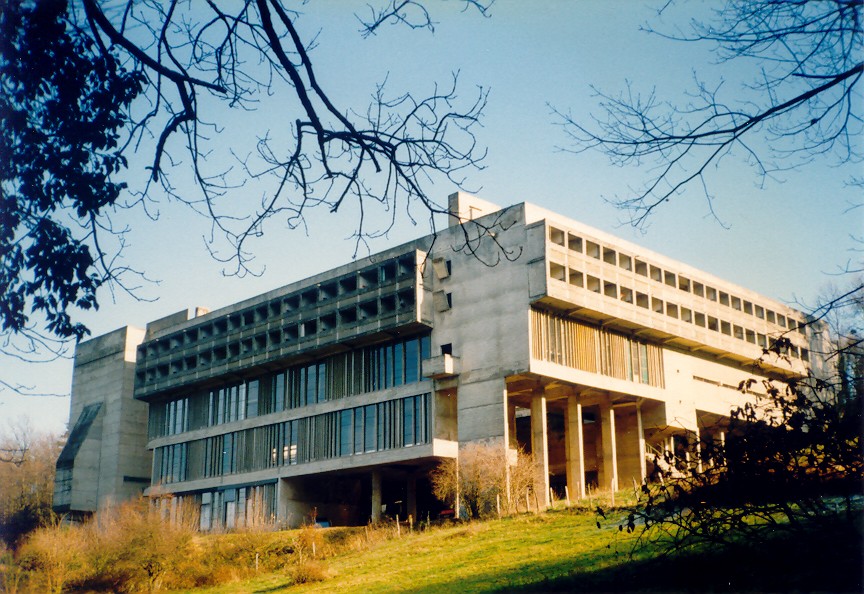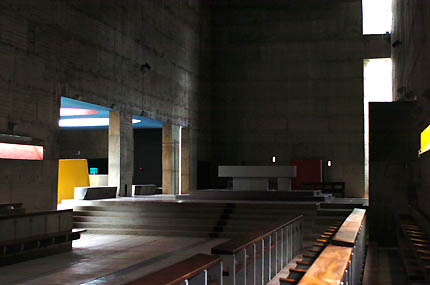“My monastery descends from the heavens, touching the earth only where it must.” – Le Corbusier. A sacred melancholy. An esthetic hardness at the expense of spirituality. Not much glory here. Little aura of radiance that emanates from god, no splintering flashes that confirm his omnipotence and grandeur. Certainly not much of the feminine. More like a hyper-rationalist, male-centric machine. A living machine?
Several of the avant-garde have taken a stab at building churches, but however cutting-edge their architecture, the churches still serve traditional religion, and not a giant filing cabinet for human ego. The Church is still based on the old-fashioned idea that transcendence is the prerogative and gift of God, one which is jealously guarded, instead of the innate need of the individual, one that can be satisfied by a sense of entitlement and perhaps by their own efforts. Typically, transcendence is displaced from individual to god, more specifically, a spiritual space inaccessible to people save by the grace of God, who in the final analysis is civilization’s alienated need for transcendence, hopefully restored to it among the faithful depending on the who/what/when/where/whys and ifs and buts on prayers being granted.
A concrete pyramid juts from the centre of the building. From the outside some corridors seem to slope, drunkenly. The whole foursquare building is supported on one side by a bank of grass, and on the other by spindly and irregular concrete legs…. Almost spookily so. The architect of La Tourette really was linked to the Nazis (he admired Hitler); the building really did have an eerie and malign reputation;…
Inside, it’s even eerier. The monastery is inhabited by twenty Dominican monks. This is down from the original ninety who assumed control of the monastery in the 1950s, once Corbusier had finished his work. This attrition is apparently a result of the building itself: many of the original brothers found the concrete construction so oppressive they developed psychoses and nervous breakdowns. Entrance is gained to La Tourette at a square and concrete box to the rear…. Read More:http://www.tomknoxbooks.com/marks-of-cain/marks-of-cain-the-monastery-of-la-tourette/

---The whole Monastery is set on a steeply sloping bank within its grounds, on a spot chosen by Le Corbusier. Each of the hundred cells has an outward-facing balcony, with the communal areas beneath, and the cloister, unconventionally, running around the roof.--- Read More:http://www.galinsky.com/buildings/latourette/
…a complete, self-contained world for a community of studying, silent monks, living a life so austere they are sometimes known as the ‘begging brothers’. The building has 100 individual cells, communal library, classrooms and refectory, a rooftop cloister and church. Many of Le C’s long-established practices are here: the pilotis (load-bearing columns) inside the walls freeing the facade for long strip windows, the grassed rooftops and the carefully planned architectural promenade with ramp; but the austerity and spirituality of the monks’ life gives a very different outcome. “Trying to give the monks what men today need most: silence and peace…this monastery does not show off; it is on the inside that it lives.” Read More:http://www.mimoa.eu/projects/France/Eveux/Monastery%20of%20Sainte-Marie%20de%20La%20Tourettea

---Consensus among Le Corbusier scholars reveals that he “had no place for institutionalized religion within his ideal society.” Nonetheless, Couturier’s philosophy of art and his personal friendship with Le Corbusier made the architect the obvious choice to design a monastery rooted first in modernist art, secondarily in religion. By mistaking the “spirit of the age,” or Zeitgeist, for the Holy Spirit, Couturier assisted in the production of structures by famous modernist architects at the expense of the essential features of Catholic artistic work. Couturier sought to renew sacred art and architecture in much the same way Le Corbusier sought to renew architecture: through the utilization of powerful contemporary forms and materials. Couturier remained disappointed in much nineteenth and twentieth-century church art in which pallid, sentimental images were copied and recopied. As a remedy, Couturier placed his trust in artists, believing that all true art revealed something of the sacred. Since true art could only be revealed by true artists, he therefore sought the services of the masters of his time, Catholic or not, to reach the sacred through the production of a supposedly “true” art. ---Read More:http://www.sacredarchitecture.org/articles/almost_religious_couturier_lecorbusier_and_the_monastery_of_la_tourette/
Its an architectural style called brutalism. Ultimately, in its break from historicism, it lacks spiritual ambition, the convincing synthesis of aspiration and willpower that were invoked by traditional structure which implies a displacement of transcendence; the descent into death without subsequent ascent to a form of salvation from death. Ironically, Tourette is something like a crypt, a catacomb, a religious warehouse needing skulls and bones to make it complete as a self-enclosed entity on death without transcendence. An ironical joke?
…It is truly bizarre. For a start it is almost uniformly grey. Greyer than grey; as grey as the ghost of Lady Jane Grey. The only colour come from the various big windows, designed for proper appreciation of the Rhone Valley views. These windows have bright red and orange curtains; the clash with the penitential drabness of the rest of the building is peculiar….Built by the famous (some say infamous) French Swiss architect Le Corbusier, this modernist monastery looks like a cross between a multi-storey car park in Bracknell and, well, another multi-storey car par in Bracknell. And yet, a few nights here can provide the most remarkable spiritual experience of a lifetime. And you don’t get many of those in Bracknell….( Tom Knox ) Read More:http://www.tom
books.com/marks-of-cain/marks-of-cain-the-monastery-of-la-tourette/ADDENDUM:
Perhaps because of Le Corbusier’s “problem” with building churches, he handed off much of the design work for the most sacred sections—the chapel and the altar—to his assistant Iannis Xenakis. In 1987, Xenakis wrote a detailed memoir of his time with Le Corbusier on the La Tourette project, revealing his own philosophies on the subject. Xenakis wrote:
In the face of this project I had to struggle against my atheism rooted in ancient civilizations and, having been an orthodox Christian, against the “schismatic” reflexes buried in my psychic unconscious. As a matter of fact I felt suited to create as if I were a believer, since I had escaped twofold from religion – from the ancient religion with which I had been impregnated as well as from Christianity. I possessed the necessary critical distance.
By “betting on genius” Couturier appointed a struggling atheist who had “escaped” from Christianity to design his chapel. Regarding the design process for the monastery’s high altar, Xenakis compared Christ to Dionysos and the sacrifice of the Mass to Aztec worship:
I designed a high altar that was judged by the monks to be too abrupt, too high, too separative. In fact I had conceived it a little like a place for terrible sacrifices. It was too dramatic, too Aztec. Christ sacrificed himself, as did Dionysos, but the drama had to remain internal and luminous. Read More:http://www.sacredarchitecture.org/articles/almost_religious_couturier_lecorbusier_and_the_monastery_of_la_tourette/






 COMMENTS
COMMENTS